If you’ve ever asked yourself, “How long does it take to remove a tattoo?”, you’re not alone. Tattoo removal is a popular topic, but it can be difficult to find definitive answers. The truth is, there is no one-size-fits-all answer to how long it takes to remove a tattoo. It depends on a variety of factors, such as the type of tattoo, the size of the tattoo, the type of laser used in the removal process, and more. In this article, we’ll discuss the various factors that can affect tattoo removal time, as well as provide tips on how to speed up the process. Read on to get the facts now!
Contents
What is Tattoo Removal?

Tattoo removal is the process of removing an existing tattoo from the skin. There are several methods of tattoo removal, such as laser removal, excision, dermabrasion, and chemical peels.
Laser removal is one of the most popular methods of tattoo removal. It involves the use of high-intensity light beams to break up the tattoo ink particles. The laser light is absorbed by the tattoo ink particles and then they are broken up and absorbed by the body.
Excision is the process of surgically removing the tattoo. This method is more invasive and requires more time to heal. The skin is cut open, and the tattoo is cut out and removed.
Dermabrasion is a method of tattoo removal that uses a rotating wire brush to remove the tattoo from the skin. This method is less invasive and takes less time to heal.
Chemical peels are another method of tattoo removal. This method involves the use of a chemical solution that is applied to the skin and allowed to sit for a period of time. The chemical solution breaks down the tattoo ink and helps to remove it from the skin.
No matter what method you choose, it is important to note that it will take time to remove a tattoo. The amount of time it takes to remove a tattoo varies depending on the type of tattoo, its size, and the method used.
If you are interested in learning how to remove a new tattoo, it’s important to understand the risks and benefits of each method. You should also consult with a qualified tattoo removal professional before deciding on a method of tattoo removal.
Pros and Cons of Tattoo Removal
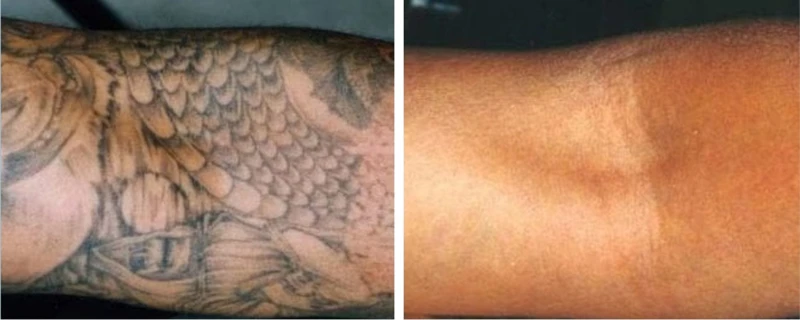
| Pros | Cons |
|---|---|
|
|
Tattoo removal can be a great option for people who want to remove tattoos they no longer want to keep. However, it is important to be aware of the potential pros and cons of this procedure. For example, while it can be helpful for people to remove tattoos they regret and make room for new tattoos, it can be expensive, painful, and leave behind scars. It is also important to note that lasers are not recommended for new tattoos as the ink is still settling in the skin and may result in scarring.
Factors That Affect Tattoo Removal
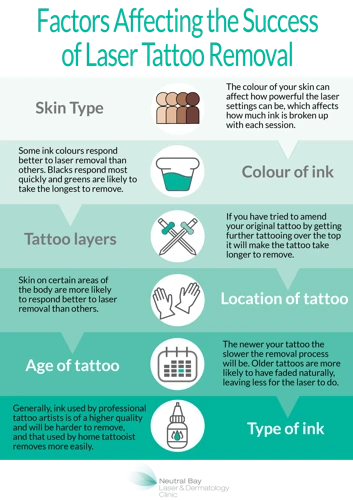
Tattoo Age
Older tattoos tend to be easier to remove than newer tattoos, as the pigments used in newer tattoos are typically more deeply embedded in the skin. The age of the tattoo also affects how soon you can remove it.
Tattoo Color
Darker and brighter colors are more difficult to remove than lighter colors. This is because they are more deeply embedded in the skin and require more energy to break them down.
Tattoo Location
The location of the tattoo also affects the removal process. Tattoos on areas of the body that have less blood flow, such as the hands, feet, and face, are more difficult to remove than those on areas with better circulation, such as the arms and legs.
How Long Does It Take to Remove a Tattoo?
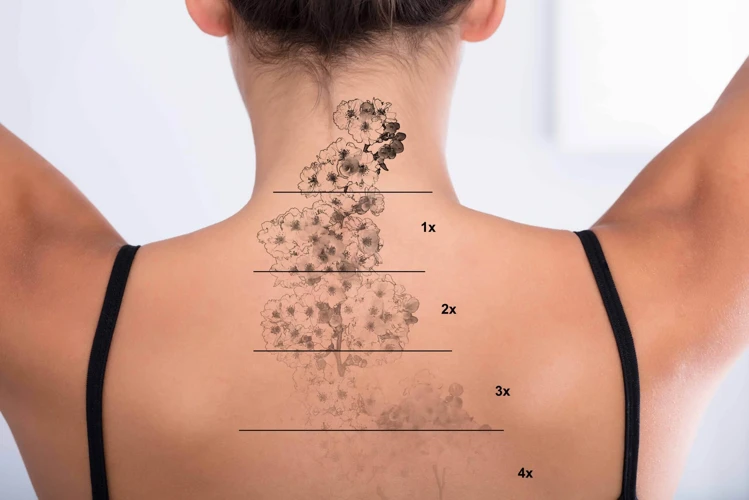
How Long to Remove a New Tattoo?
The process of removing a new tattoo begins with the laser light breaking down the ink into particles small enough for the body to naturally flush out. The number of treatments needed to remove a new tattoo depends on the size and color of the tattoo, and can take anywhere from a few weeks to up to a year.
How Soon Can You Remove a Tattoo?
Most tattoos can be safely and effectively removed within 8 to 10 treatments, although some can take as few as 4 treatments and others as many as 20. The average number of laser treatments needed to remove a tattoo is 8 to 10, with each session spaced between 6 to 8 weeks apart.
How Long Does It Take to Laser Remove a Tattoo?
The time it takes to remove a tattoo using laser technology depends on the size and color of the tattoo, as well as the type of laser used. Generally, it can take anywhere from 6 to 12 months to completely remove a tattoo.
How to Remove a Brand New Tattoo?
The process of removing a brand new tattoo is the same as removing an older tattoo. Laser technology is used to break down the pigment of the tattoo ink into small particles, which are then naturally flushed out of the body over time.
How to Remove a Tattoo Before it Heals?
Removing a tattoo before it has had time to heal is not recommended, as it can lead to scarring and other complications. If you wish to remove a tattoo, it is best to wait for it to heal completely before beginning the removal process.
How Often Can You Get Tattoo Laser Removal?
The number of laser treatments needed to completely remove a tattoo depends on the size and color of the tattoo, as well as the type of laser used. Generally, it is recommended to wait 6 to 8 weeks between each treatment session.
Cost of Tattoo Removal
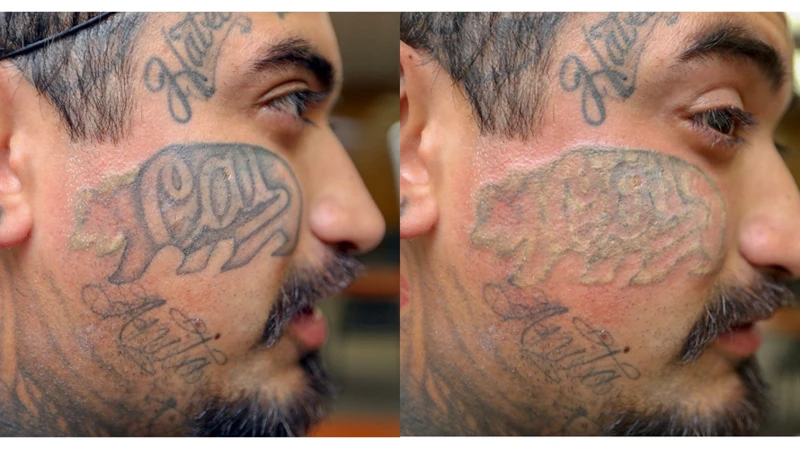
The cost of tattoo removal depends on a few factors, including the size of the tattoo, the type of ink used, and the type of laser used for the procedure. In general, laser tattoo removal can cost anywhere from $200 to $1000 per session. Multiple sessions may be needed to completely remove the tattoo, so the total cost can be quite high.
The cost of removing a brand new tattoo may be cheaper than removing an old one. This is because the ink has not had time to settle into the skin, making it easier to remove. Additionally, the amount of ink used in a new tattoo is typically less, so the laser may not need to be used as many times.
It’s important to note that the cost of tattoo removal can vary widely depending on the provider and the size of the tattoo. When considering tattoo removal, it’s important to research different providers and get an accurate estimate of the cost before proceeding.
Alternatives to Tattoo Removal
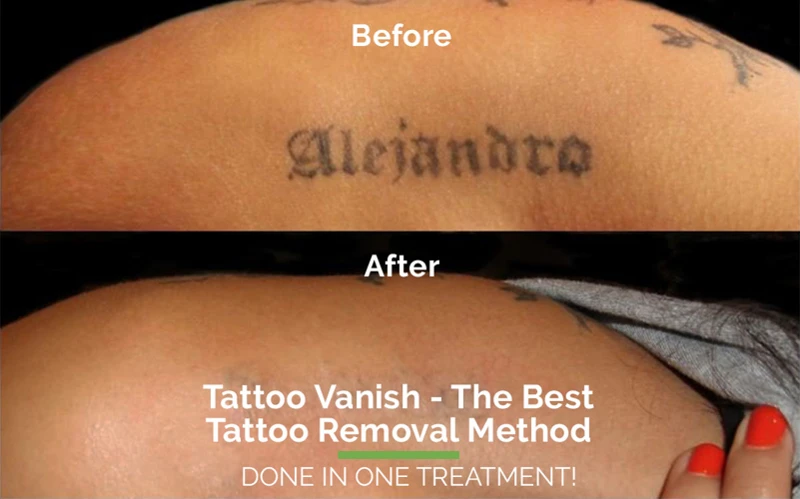
There are several alternatives to tattoo removal, depending on how long the tattoo has been there and how deep it is. For tattoos that are still fresh, a topical ointment or laser therapy can be used to lighten and remove the ink. If the tattoo is older, cryosurgery or dermabrasion may be used to remove the ink.
Topical Ointment
Topical ointment can be used to lighten or remove a tattoo that is still fresh. It is applied directly to the tattoo and works by breaking down the ink particles which can then be removed by the body’s natural healing process.
Laser Therapy
Laser therapy is a common form of tattoo removal and is used for tattoos that are still fresh. It works by breaking down the ink particles with a high-intensity light beam. The laser energy is absorbed by the pigment in the tattoo, resulting in the ink particles being broken down and then removed by the body’s natural healing process.
Cryosurgery
Cryosurgery is a more invasive form of tattoo removal and is used for tattoos that are older. It involves freezing the tattooed area with liquid nitrogen and then removing the ink particles with a scalpel. This procedure is usually done under local anesthesia.
Dermabrasion
Dermabrasion is another form of tattoo removal and is used for tattoos that are older. It involves using a specialized tool to sand down the tattooed area and then removing the ink particles with a scalpel. This procedure is usually done under local anesthesia.
Preventing Tattoo Removal
In order to minimize the need for tattoo removal, proper aftercare is essential. It is important to keep the tattooed area clean and moisturized, and to avoid picking or scratching at the area. Additionally, the tattoo should not be exposed to direct sunlight or extreme temperatures. If a tattoo is still healing, it is important to avoid any activities that may cause it to be rubbed or scratched, as this can lead to scarring and even the need for tattoo removal.
Safety and Risks of Tattoo Removal
Tattoo removal is a safe procedure when done by a qualified professional. Nevertheless, it is important for patients to be aware of the risks associated with this type of procedure. Common risks include: infection, scarring, and changes in skin pigmentation. In some cases, it is possible for the tattoo to become more visible after the removal process.
It is important to keep the area clean and dry after treatment. Additionally, you should avoid direct sunlight, especially during the healing process. If you experience any pain, swelling, or redness, you should contact your health care provider.
When considering how often can you get tattoo laser removal, it is important to speak to your doctor. The number of treatments you will need depends on a variety of factors, including size, colour, and location of the tattoo. In general, it is best to space treatments apart by 4-6 weeks, as your skin needs time to heal between sessions.
Frequently Asked Questions
What Types of Tattoos Can Be Removed?
Tattoos come in many shapes and sizes, and the type of tattoo can affect how easily it can be removed. Smaller tattoos, for example, are typically easier to remove than larger ones. Additionally, tattoos with fewer colors, such as black and gray, are generally easier to remove than those with multiple colors. Other factors, such as the age of the tattoo and the location of the tattoo will also affect the process. Consult with a professional tattoo removal specialist to determine the best approach for your specific tattoo.
Is the Removal Process Painful?
Tattoo removal can be uncomfortable and may cause some mild pain or discomfort. However, pain levels vary from person to person depending on the size and location of the tattoo. The modern laser tattoo removal process is much less painful than the traditional methods of tattoo removal. Most people compare the feeling of laser tattoo removal to the sensation of a rubber band snapping against the skin. Painkillers can be taken to reduce any discomfort.
Are there any risks associated with tattoo removal?
Yes. Tattoo removal comes with risks, just like any medical procedure. These include:
- Pain during and after the procedure
- Swelling, redness, and itching at the site of the tattoo
- Skin discoloration
- Scarring
- Infection
It is important to discuss the risks with your doctor and make sure you are comfortable with the procedure before proceeding.
Are There Any Aftercare Instructions That Need to Be Followed After Removal?
Yes. Aftercare instructions need to be followed after tattoo removal to ensure the best results.
- Avoid exposing the area to the sun as much as possible.
- Keep the area clean and dry.
- Do not scratch or pick at the skin.
- Apply a moisturizer to keep the skin hydrated.
- Avoid activities that will cause the area to sweat.
- Do not use any other skin treatments on the area.
It is important to follow these instructions for the optimal healing process and best results. Be sure to consult your doctor or tattoo removal specialist if you have any questions or concerns.
How Much Does It Cost to Have a Tattoo Removed?
- Laser tattoo removal: On average, laser tattoo removal costs between $200 to $500 per session and may require several sessions, depending on the size and color of the tattoo. Each laser tattoo removal session can take anywhere from 10 minutes to an hour.
- Dermabrasion: Dermabrasion is a process which is used to remove the top layers of skin from a tattoo. This process can cost up to $1,500 and can take several sessions.
- Surgical excision: Surgical excision is a process which involves cutting out the tattooed area of skin and stitching it back together. This process can cost up to $2,000 and will require stitches and anesthesia.
- Tattoo removal creams: Tattoo removal creams are available over the counter and can cost anywhere from $20 to $100. However, these creams usually take several months to show any results.
Conclusion
Tattoo removal is a long process that can take anywhere from a few months to several years depending on the size and complexity of the tattoo. Laser tattoo removal is the most common and effective method of tattoo removal, although other methods such as dermabrasion, salabrasion, and excision are also available. As with any medical procedure, it is important to consult a professional before deciding on the best option for you.
References
- How Long Does It Take to Remove a Tattoo? (Tattoo Health)
- Laser Tattoo Removal: Benefits, Side Effects, and Cost (WebMD)
- Tattoo Removal (Wikipedia)